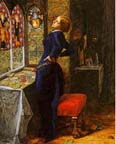 Sir John Everett Millais based Mariana (1851) upon Tennyson's poem of the same name, which derives from Shakespeare's Measure for Measure and tells of a woman who has lived alone for five years after having been rejected by her fiancé, Angelo, after her dowry was lost in a shipwreck. Millais chose to illustrate the following lines:
Sir John Everett Millais based Mariana (1851) upon Tennyson's poem of the same name, which derives from Shakespeare's Measure for Measure and tells of a woman who has lived alone for five years after having been rejected by her fiancé, Angelo, after her dowry was lost in a shipwreck. Millais chose to illustrate the following lines:
She only said, "My life is dreary,
He cometh not," she said;
She said, "I am aweary, aweary
I would that I were dead!"
Alone in her house on a grey autumn afternoon, Mariana stands up from her needlework to stretch her back and look longingly out the window. Autumn leaves are scattered about on the floor. The changing of the season from summer to fall is impending, so much so that it is overtaking the interior of Mariana's home. Just as the seasons change outside, the fertile spring and summer of Mariana's life is coming to a close as she is left alone, facing life as a lonely spinster.
The painting includes references to more than one Tennyson poem, in particular, "St. Agnes' Eve." St Agnes' Eve is January 20th, and it is traditionally the day when maidens have visions of their lovers. The flower in the stained glass window is the snowdrop and represents "consolation." It is also the birthday flower for January 20th. In her pained posture and facial expression, Mariana is perhaps visualizing her lost lover. The inscription above the snowdrop in the window reads, "In coelo quies," or "In Heaven there is rest." The inscription mimics Mariana's desire for the end of her life, whether the literal end or just the end of her life as a solitary woman. The shadowed altar behind Mariana with a single burning candle indicates a glimmer of hope, though the rest of the picture presents an overwhelming gloomy mood. In contrast to Mariana's dissatisfaction, the stained glass windows directly in front of her workspace show the Annunciation, a time of great fulfillment for the Virgin Mary. This comparison heightens the feeling of discomfort and pain that Millais so effectively depicts in Mariana's gesture and facial expression,. The mood that's created by the contrast in light and dark colors and the interior and exterior worlds coming together also add to the contrast.
Questions
1. In the original sketch for the figure of Mariana, Millais sketched Mariana in two different poses, one as he depicted in the painting, with her back to the viewer, and one with cupped hands looking down, facing the viewer. How would the painting's mood have been different if he had chosen to depict her looking down, facing us? Why do you think Millais made this choice?
2. In Tennyson's poem Mariana looks out on "gloaming flats" with a single poplar tree to interrupt the monotonous landscape. Millais took some artistic license with the scene outside when, instead of a vast emptiness outside the window, he chose to depict branches and trees pressing against the windows and crowding her view. What impact does this choice have on the painting? What sort of mood or emotion does the juxtaposition of the outside scenery and the interior environment create?
3. Millais makes references to other Tennyson poems in "Mariana," since the mouse in the lower right-hand corner is apparently from "St. Agnes' Eve." Doesthe mouse has any other meaning other than being a reference to another poem? Is the mouse simply a part of the interior scene, or did Millais put it there to tell the viewer something?
Related Materials
Bibliography
Millais, John Guile. The Life and Letters of John Everett Millais, President of the Royal Academy. 2 vols. New York: Frederick A. Stokes, 1899.
Last modified 27 September 2004